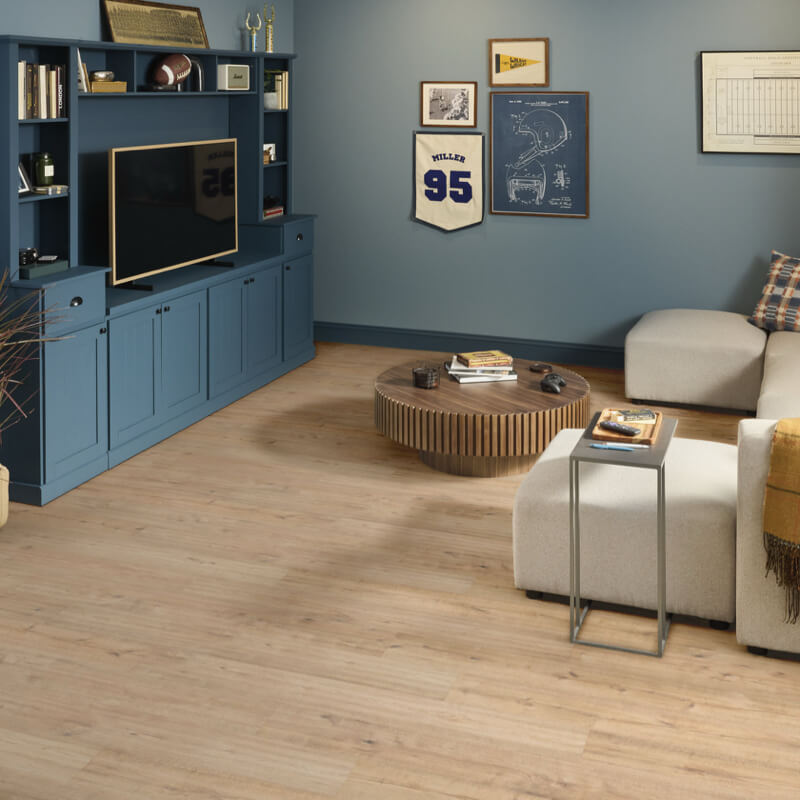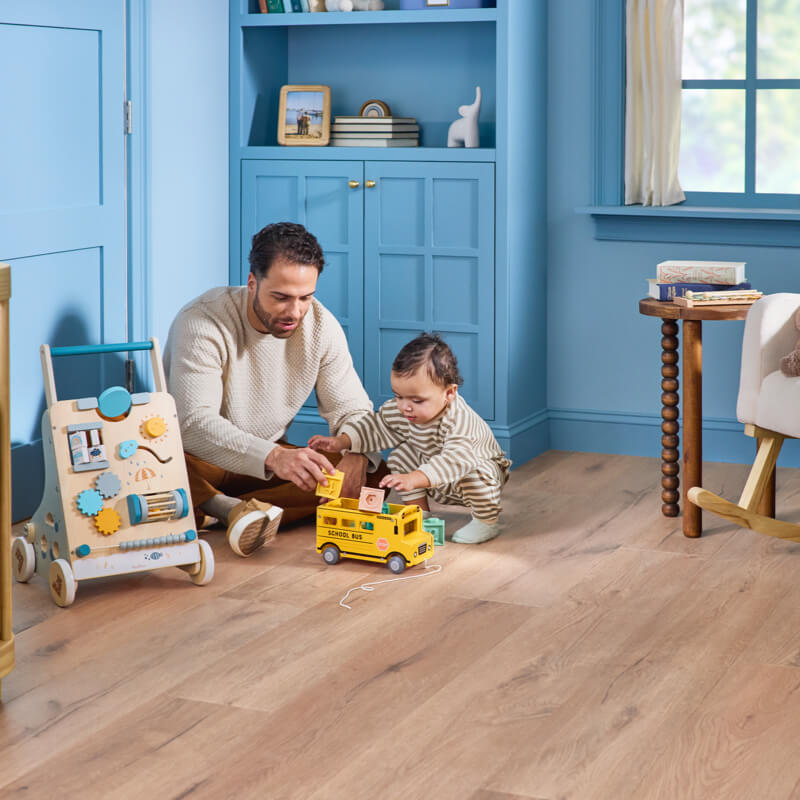The Homeowner’s Guide to Choosing LVP, Laminate, or Engineered Wood
It’s hard to beat the beauty of hardwood floors in your home. They bring warmth, texture, and timeless character that elevate any space.
But solid hardwood isn’t always the right choice for every project. In the wrong environment, it can scratch, dent, or warp when exposed to moisture.
Today’s homes are busier than ever, requiring flooring that withstands heavy use while maintaining its beauty. If you love the charm of solid wood but need something more resilient, there are excellent alternatives.

Engineered wood, luxury vinyl plank (LVP), and laminate each capture the natural wood-look while offering their own balance of durability, maintenance, and performance.
Whether you’re drawn to the genuine wood grain of engineered hardwood, the scratch-resistant strength of laminate, or the waterproof durability of luxury vinyl plank, you’ll find options that meet your lifestyle and design goals without compromise.
Comparing Today’s Wood-Look Flooring Options
Engineered hardwood, luxury vinyl plank, and laminate all deliver the inviting look of solid hardwood, but they differ in construction, performance, and price. Understanding how each compare to traditional solid hardwood will help you choose the best fit for your space.
Engineered Hardwood
Engineered hardwood is genuine wood. While solid hardwood is made from a single piece of lumber, engineered hardwood features a plywood or fiberboard core topped with a real hardwood veneer. The cross-laid core adds strength and stability, making engineered hardwood less likely to expand or contract with changes in humidity. This construction makes it more versatile than solid hardwood and better suited for spaces like kitchens, basements, or over radiant heat systems.
How it differs from solid hardwood:
- Construction: Engineered hardwood is built with a real hardwood surface over a stable, multi-layer core, giving it greater resistance to moisture and temperature changes than solid hardwood.
- Refinishing potential: Depending on the thickness of the veneer, it can typically be sanded and refinished a few times, while solid hardwood can be refinished many times throughout its lifespan.
- Installation options: Engineered hardwood can be glued, nailed, stapled, or floated, offering more flexibility for installation compared to solid hardwood, which generally must be nailed down.
- Price point: It tends to cost slightly less than solid hardwood, particularly for wider planks or premium species.
Luxury Vinyl Plank (LVP)
Luxury vinyl plank is a 100% synthetic flooring designed to replicate the look and texture of natural wood. It’s composed of several layers, including a waterproof core, a high-resolution photographic film, and a durable wear layer for protection. Modern printing and embossing technologies allow luxury vinyl to capture realistic wood grain patterns and textures, creating the warmth of wood with added practicality.
How it differs from solid hardwood:
- Waterproof performance: LVP is completely waterproof, making it ideal for kitchens, bathrooms, laundry rooms, and basements where solid hardwood cannot be installed safely.
- Durability: The wear layer shields the surface from scratches, dents, and stains, providing long-lasting protection that requires minimal maintenance.
- Comfort and acoustics: LVP feels softer and quieter underfoot than hardwood, especially when installed with an attached pad or underlayment.
- Cost: It is typically more affordable in both materials and installation, offering the appearance of wood at a fraction of the price of solid hardwood.
Laminate
Laminate flooring features a high-density fiberboard (HDF) core topped with a photographic image of wood and sealed under a protective melamine wear layer. Though entirely man-made, laminate has advanced significantly in visual realism, with embossed textures that follow the printed grain pattern to mimic the natural variation of wood.
How it differs from solid hardwood:
- Moisture resistance: Most modern laminate flooring is water-resistant, though its fiberboard core can still be damaged by standing water, unlike solid hardwood, which absorbs moisture more quickly and can warp.
- Surface strength: The protective top layer makes laminate exceptionally scratch-resistant, often outperforming hardwood in busy households with pets or heavy foot traffic.
- Maintenance: Laminate cannot be refinished like hardwood, but it’s easy to care for with regular sweeping and damp mopping.
- Price: It’s one of the most affordable wood-look flooring options and offers simple click-lock installation, making it a popular choice for quick updates.

How to Choose Between Engineered Hardwood, Luxury Vinyl Plank, and Laminate
Selecting the right wood-look floor involves both performance and style. Each option has strengths in durability, moisture resistance, color, and texture, which influence how it pairs with cabinets, furniture, and décor. Thinking about how each floor fits your home and lifestyle ensures a cohesive, long-lasting result.
Choosing the Right Floors for Each Room
Every room in your home experiences a different level of activity, moisture, and wear. The best wood-look floor for each space depends on how it’s used and the atmosphere you want to create.
- Engineered Hardwood: Ideal for living rooms, bedrooms, and dining areas. These spaces benefit from the natural warmth and texture of real wood, while engineered construction adds stability and resilience.
- Luxury Vinyl Plank (LVP): A smart choice for kitchens, bathrooms, laundry rooms, and basements. Its waterproof core resists moisture and spills, allowing the look of wood to extend into areas where traditional hardwood would struggle.
- Laminate Flooring: Works well in entryways, hallways, and other high-traffic areas. Its durable wear layer protects against scratches and dents, making it a practical option for families with pets or children while still offering a realistic wood appearance.
Matching Your Floors to Your Lifestyle
Beyond room placement, your lifestyle plays a big role in selecting the right flooring. Consider how you live day-to-day and the level of maintenance, durability, and resilience you need.
- Engineered Hardwood: Best for moderate- to high-traffic areas where you want genuine wood character. Ideal for homeowners who value craftsmanship, long-term investment, and a balance of beauty and durability.
- Luxury Vinyl Plank (LVP): Perfect for high-traffic spaces. Its waterproof, scratch- and dent-resistant surface makes it ideal for homes with kids, pets, or frequent entertaining, while remaining comfortable underfoot.
- Laminate Flooring: Well-suited for medium- to high-traffic areas. Its tough wear layer resists scratches, dents, and fading, making it a reliable choice for active households that want the look of wood without high maintenance.
Matching Your Floors to Your Design Style
Appearance is key to creating a polished home. Coordinating color, texture, and finish with cabinets, furniture, and décor ensures a unified look.
- Engineered Hardwood: Complements traditional, transitional, or classic interiors. Warm tones like oak, walnut, or hickory enhance neutral walls and furniture, while wider planks create visual flow in open spaces.
- Luxury Vinyl Plank (LVP): Best for contemporary, modern, or casual styles. Available in varied colors and textures, including distressed or hand-scraped looks, it pairs seamlessly with bold cabinetry, patterned rugs, or textured décor.
- Laminate Flooring: Supports functional or budget-conscious spaces. Neutral shades, gray tones, or light wood finishes coordinate with light cabinets and furnishings, and surface textures add depth to prevent a flat appearance.

Finding the Perfect Wood-Look Floor for Your Home
Choosing between engineered hardwood, luxury vinyl plank, and laminate comes down to matching the floor to your space, lifestyle, and style preferences. Each option delivers a wood-inspired aesthetic, but their strengths differ: engineered hardwood offers genuine wood character and refinishing potential, LVP brings waterproof durability for high-traffic and moisture-prone areas, and laminate provides scratch-resistant performance at an affordable price.
No matter which floor you choose, thinking about the room, daily activity, and design goals ensures your wood-look flooring will feel intentional, functional, and beautiful for years to come.
Visit Carpet Specialists in Louisville, KY and Jeffersonville, IN to see full planks, experience textures underfoot, and get guidance on the best flooring for your home and lifestyle.
